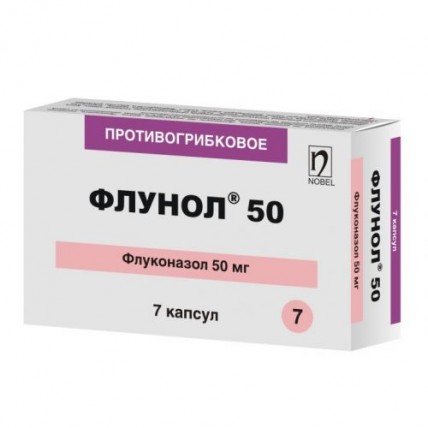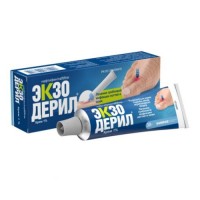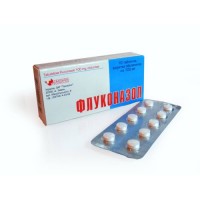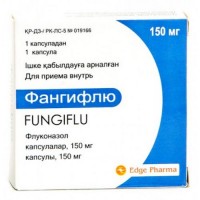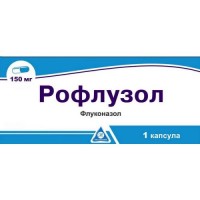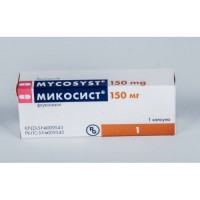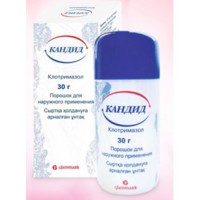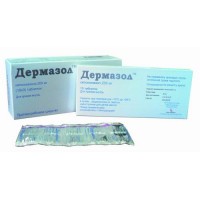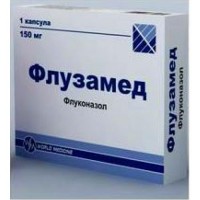Flunol 7's 50 mg capsules
- $22.40
The instruction for medical use
of ФЛУНОЛ® 50 medicine
the Trade name
ФЛУНОЛ® 50
International unlicensed
name Flukonazol Lekarstvennaya a form
of the Capsule, 50 mg
Structure
One capsule contains
active agent – flukonazol 50 mg,
excipients: lactoses monohydrate, silicon dioxide colloidal (Aerosil 200), starch corn, magnesium stearate, sodium lauryl sulfate,
structure of a cover of the capsule:
body: titan dioxide (E 171), gelatin,
lid: the titan E 171 dioxide, scintillating black (E151), gelatin
the Description
Solid gelatin capsules of No. in size 3 with the opaque body of white color and an opaque lid of dark blue color.
Pharmacotherapeutic group
Antifungal drugs for system use. Triazole derivatives. Flukonazol.
The ATX J02AC01 code
the Pharmacological
Flukonazol Pharmacokinetics properties is well soaked up after oral administration, the bioavailability is more than 90%. Meal does not affect absorbability of drug. The maximum concentration is reached in 0.5 - 1.5 hours. Flukonazol well gets into fluid mediums of an organism. Levels of a flukonazol in saliva, a phlegm approach its concentration in plasma. At patients with fungal meningitis the level of a flukonazol in cerebrospinal fluid is about 80% of level it in plasma.
In a corneal layer of epidermis, a derma and sweat glands high concentrations of a flukonazol which exceed serumal are reached. Flukonazol badly contacts proteins of plasma (12%). Elimination half-life makes 30 hours. Is not exposed to metabolism. Metabolites of a flukonazol in peripheral blood are not revealed. Flukonazol is brought mainly by kidneys, about 80% of the accepted dose are found in urine in not changed look.
Pharmacokinetics in special clinical cases
At children the following pharmacokinetic parameters of a flukonazol were revealed:
Age of children
Dose (mg/kg)
Elimination half-life (hour)
of AUC (mkg. h/ml)
11 days –
11 months
the Single dose - 3 mg/kg
of 23 110.1 9 months –
13 years
the Single dose - in 2 mg/kg
of 25.0
94.7
9 months –
13 years
the Single dose - in 8 mg/kg
of 19.5 362.5 5 years-15 of years
the Reusable dose - 2 mg/kg
of 17.4
67.4
5 years-15 of years
the Reusable dose - 4 mg/kg
of 15.2 139.1 5 years-15 of years
the Reusable dose - 8 mg/kg
the Reusable dose - in 3 mg/kg
to 15.5
41.6
Premature children (about 28 weeks of development) flukonazol entered 17.6,196.7 Average age of 7 years in/in in a dose of 6 mg/kg every 3rd day before introduction of at most 5 doses at that time while children remained in the intensive care unit (ICU). Average T1/2 made 74 h in the 1st day, with reduction for the 7th day, on average, up to 53 h and for the 13th day, on average, up to 47 h (within 27-68 h).
AUC values were 271 мкг×ч/мл in the 1st day, then increased to 490 мкг×ч/мл for the 7th day and decreased on average to 360 мкг×ч/мл by 13th day.
Vd made 1183 ml/kg in the 1st day, then increased, on average, to 1184 ml/kg for the 7th day and to 1328 ml/kg - for the 13th day.
A pharmacodynamics
Flukonazol is the representative of a class of triazolny antifungal means, is selection inhibitor of synthesis of ergosterol in a membrane of fungi. Increases permeability of a cellular membrane, breaks its growth and replication. Pharmacological effect - fungicidal. Has specific effect on the fungal enzymes dependent on P450 cytochrome. Has no anti-androgenic activity. Treatment flukonazoly in a dose of 50 mg/days within 28 days did not affect concentration of testosterone in blood at men or concentration of steroids at women of childbearing age. Flukonazol is effective in superficial and system fungal infections which are caused by Candida spp., Cryptococcus neoformans, Coccidiodes immitis, Microsporum spp., Trichophyton spp., Blastomyces dermatitidis, Histoplasma capsulatum.
Indications
- genital candidiasis, acute or recurrent vaginal candidiasis, prevention for the purpose of reduction of frequency of a recurrence of vaginal candidiasis, a candidosis balanitis
- candidiasis of mucous membranes, including mucous oral cavities, drinks, a gullet, noninvasive bronchopulmonary infections, a kandiduriya, skin and mucous and chronic atrophic candidiasis of an oral cavity
- a dermatomycosis, including mycoses of feet, smooth skin of a trunk, extremities, a chromophytosis, skin candidosis infections
- generalized candidiasis, including a kandidemiya, disseminate candidiasis and other forms of an invasive candidosis infection, such as infections of a peritoneum, endocardium, respiratory and uric ways, including at the patients with malignant tumors who are in intensive care units and receiving cytotoxic or immunosuppressive therapy and also at patients with other factors contributing ment of candidiasis
- a cryptococcosis, including cryptococcal meningitis and infections of other localization (for example, lungs, skin), including at patients with the normal immune response and patients with AIDS, recipients of transplanted organs and patients with other forms of an immunodeficiency, maintenance therapy for the purpose of prevention of a recurrence of a cryptococcosis at patients with AIDS
- prevention of fungal infections at the patients with malignant new growths predisposed ment of such infections as a result of cytotoxic chemotherapy or radiation therapy
the Route of administration and doses
by the Adult:
- in oropharyngeal candidiasis in the first day drug is usually appointed on 200 mg, then continue 100 mg once a day. Treatment is continued within 2 weeks to reduce recurrence probability.
- In vaginal candidiasis accept once inside in a dose 150 mg. For decrease in frequency of a recurrence of vaginal candidiasis drug can be used in a dose of 150 mg once a month. Duration of therapy is determined individually – it varies from 4 to 12 months
- In chronic recurrent vulvovaginal candidiasis (frequency of a recurrence of 4 and more times a year) is recommended pulse therapy: on 150 mg once a week within 1-3 months.
- In a candidosis balanitis – once 150 mg.
- In skin mycosis the recommended dose makes 150 mg once a week. Therapy duration in everyday occurences is 2-4 weeks, however in mycoses of feet longer therapy can be required (up to 6 weeks).
- In an onychomycosis the recommended dose of 150 mg once a week. Treatment should be continued before growth of not infected nail. Repeated growth of nails on fingers of hands and feet normal requires 3-6 and 6-12 months respectively.
- In a chromophytosis of 300 mg once a week, within 2 weeks.
Use for children
As well as for adults, in similar infections, duration of treatment depends on clinical and mycologic effect.
The maximum daily dose for adults should not be exceeded at children. Flukonazol is accepted every day in a single dose. In candidiasis of mucous membranes of 6 years the dose of Flunola® is also more senior makes 3 mg/kg/days. In the first day for the purpose of faster achievement of constant equilibrium concentration the shock dose of 6 mg/kg can be appointed.
For treatment of generalized candidiasis and a cryptococcal infection the recommended dose makes 6-12 mg/kg/days depending on disease severity.
For prevention of fungal infections at the patients with an immunodeficiency who are considered in risk group owing to a neutropenia, receiving cytotoxic chemotherapy or radiation therapy, drug is appointed on 3-12 mg/kg/days depending on expressiveness and duration of preservation of the induced neutropenia.
Use for elderly people
in the absence of symptoms of a renal failure drug is appointed in a usual dose.
Use for patients with a renal failure
At single dose of change of a dose is not required. At patients, including children, with a renal failure at repeated use of drug it is necessary to enter originally a shock dose from 50 mg to 400 mg then the daily dose (depending on the indication) is established according to the following table:
Clearance of creatinine (ml/min.)
Percent of the recommended dose
& gt,
50 ≤50 (without dialysis)
Regular dialysis
of 100%
of 50%
of 100% after each dialysis
the Patients on regular dialysis have to receive 100% of the recommended dose after each dialysis, in days, when there is no dialysis, patients have to receive the reduced dose according to their clearance of creatinine.
Side effects
Often (from ≥1/100 to & lt, 1/10)
- a headache
- an abdominal pain, diarrhea, nausea, vomiting
- increase in level of alkaline phosphatase, serumal level of aminotransferases (ALT and nuclear heating plant)
- rash
Infrequently (from ≥1/1.000 to ≤1/100)
- insomnia, drowsiness
- spasms, dizziness, paresthesia, change of taste
- vertigo
- dyspepsia, a meteorism, dryness in a mouth
- a cholestasia, jaundice, the raised bilirubin
- an itching, urticaria, the increased sweating, dermatitis
- myalgia
- fatigue, an indisposition, weakness, fervescence
Is rare (from ≥1/10.000 to ≤1/1.000)
- an agranulocytosis, a leukopenia, a neutropenia, thrombocytopenia
- an anaphylaxis, a Quincke's disease
- a gipertriglitseridemiya, a hypercholesterolemia, a hypopotassemia
- a tremor
- tachycardia, blinking/trembling of ventricles, increase in an interval of QT
- hepatotoxicity, including exceptional cases with a lethal outcome, the liver failure, hepatocellular necrosis, hepatitis, hepatocellular damages
- a toxic epidermal necrolysis, Stephens-Johnson's syndrome, sharp generalized exanthematous pustulez, exfoliative dermatitis, a face edema, an alopecia
At patients with AIDS or cancer, at treatment flukonazoly and similar drugs were observed changes of indicators of blood, function of kidneys and a liver, however the clinical value of these changes and their communication with treatment are not established.
Contraindications
- hypersensitivity to a flukonazol, other components of drug or azolny substances with similar to a flukonazol structure
- a concomitant use of a terfenadin during multiple dose of a flukonazol in a dose of 400 mg/days and more
- a concomitant use of the medicines extending an interval of QT and which are metabolized by means of CYP3A4 enzyme, such, as tsizaprid, astemizol, erythromycin, Pimozidum and quinidine
- a hereditary lactose intolerance, deficiency of Lapp-lactases enzyme, glucose galactose malabsorption
- pregnancy and the period of a lactation
- children's age up to 6 years
With care
Disturbance of indicators of function of a liver against the background of use of a flukonazol, appearance of rash against the background of use of a flukonazol for patients with a superficial fungal infection and invasive/system fungal infections, simultaneous use of a terfenadin and flukonazol in a dose less than 400 mg/days, potentially pro-arrhythmic states at patients with multiple factors of risk (organic heart diseases, disturbances of electrolytic balance and the accompanying therapy contributing to the development of similar disturbances).
Medicinal interactions
At simultaneous use ФЛУНОЛА® 50:
- with coumarinic anticoagulants - flukonazol increases a prothrombin time. The patients receiving coumarinic anticoagulants have to be under stringent medical control,
- with tsizapridy - cases of the undesirable phenomena from heart are described, including paroxysms of ventricular tachycardia (arrhythmias like "pirouette"),
- with cyclosporine - control of concentration of cyclosporine in blood as its increase is possible is recommended,
- with a hydrochlorothiazide - leads to increase in concentration of a flukonazol in blood for 40%. However it does not demand change of the mode of dosing,
- with ethinylestradiol and levonorgestrel - flukonazol "concentration time" (AUC) increases their areas under a curve. However it does not influence efficiency of the combined oral contraceptive drug,
- with Phenytoinum - increase in concentration of Phenytoinum substantially can be observed. In need of use of the combined treatment with Phenytoinum, control of level of the last, and adequate selection of a dose is necessary for ensuring therapeutic concentration in serum,
- with rifampicin - leads to decrease in AUC of a flukonazol by 25% and T1/2 by 20%. It is necessary to consider expediency of increase in a dose of a flukonazol,
- with oral hypoglycemic means (sulphonylurea derivatives) - flukonazol extends their elimination half-life. Frequent control of glucose of blood and the corresponding reduction of a dose of sulphonylurea is recommended,
- with antifungal drugs from group of azolny derivatives, with terfenadiny and astemizoly - the likelihood of developing serious arrhythmias with lengthening of an interval of QT (in need of use of such combination the careful medical control is required) raises,
- with theophylline - lengthening of elimination half-life of theophylline from plasma and development of symptoms of its overdose is possible,
- with a zidovudine - leads to increase in concentration of a zidovudine in plasma. The patients receiving such combination should be observed for the purpose of identification of side effects of a zidovudine,
- with antipyrine - flukonazol in a dose of 50 mg does not influence antipyrine metabolism,
- with midazolam – flukonazol significantly increases concentration of midazolam and psychomotor effects,
- with triazolamy - increases AUC of a triazolam (single dose) approximately by 50%, Cmax for 20-32% and t½ for 25-50%, because of inhibition of metabolism of a triazolam. Dose adjustment of a triazolam can be required,
- with benzodiazepines - careful observation for the purpose of the corresponding dose decline of benzodiazepine is necessary,
- with blockers of slow calcium channels (nifedipine, isradipiny, amlodipiny, verapamil and felodipiny) - flukonazol can increase considerably system influence of antagonists of calcium channels. Frequent monitoring on side effect of drugs is recommended,
- with non-steroidal anti-inflammatory drugs (tselekoksiby, flurbiprofeny, an ibuprofen, Naproxenum, lornoksikamy, meloksikamy, diclofenac) – increases Cmax and AUC NPVP. Frequent monitoring on the side effect and toxicity connected with NPVP is recommended. Dose adjustment of NPVP can be required,
- with cyclophosphamide - increases levels of bilirubin and creatinine in blood serum. The combination can be used before the risk of increase in levels of bilirubin and creatinine in blood serum appears,
- with fentanyl - flukonazol considerably delays fentanyl elimination. The increased concentration of fentanyl can result in respiratory insufficiency,
- alfentanil: at simultaneous therapy with flukonazoly the decrease in clearance and volume of distribution and also lengthening of the period of removal of alfentanil is observed. The possible mechanism of action is the inhibition flukonazoly CYP3A4 enzyme. Alfentanil dose adjustment can be required.
- with galofantriny – flukonazol can increase concentration of a galofantrin in plasma because of the inhibiting effect on CYP3A4,
- with inhibitors of hydroxymethylglutaryl-A-reductase (GMG-KoA-reduktazy) - risk of development of a myopathy and acute necrosis of skeletal muscles increases (rhabdomyolysis) when flukonazol appoint along with GMG-KoA-reduktazy inhibitors which are metabolized through CYP3A4, such as atorvastatin and simvastatin, or through CYP2C9, such as fluvastatin. If the accompanying therapy is necessary, the patient has to be observed on emergence of symptoms of a myopathy and a rhabdomyolysis and also control of level of a creatine kinase has to be carried out. Intake of GMG-KoA-reduktazy inhibitors should be stopped if substantial increase of level of a creatine kinase is observed or if it is diagnosed or development of a myopathy/rhabdomyolysis is suspected,
- with losartany - flukonazol inhibits metabolism of a losartan to its active metabolite (E-31 74) which is responsible for the most part of antagonism of receptors of angiotensin II which occurs during treatment losartany. Patients have to control constantly arterial blood pressure,
- with methadone – concentration of methadone in blood serum increases, methadone dose adjustment can be required,
- with periwinkle alkaloid - can increase plasma levels of alkaloid of a periwinkle (for example, Vincristinum and vinblastine) and
it is required to result in neurotoxicity, because of inhibiting effect on CYP3A4, - with vitamin A careful observation of patients for the purpose of identification of the side effects connected with central nervous system,
- with vorikonazoly - co-administration of a vorikonazol and flukonazol in any dose is not recommended. Simultaneous use of an oral vorikonazol (to 400 mg there are each 12 hours in 1 day, then to 200 mg there are each 12 hours within 2.5 days) and an oral flukonazol (400 mg in the 1st day, then to 200 mg there are each 24 hours within 4 days) led to increase in concentration and AUC of a vorikonazol on average by 57% (9% of CI: 20%, 107%) and 79% (90% of CI: 40%, 128%), respectively,
- with Cimetidinum, antacids - are not observed clinically significant influence on absorption of a flukonazol,
- with Prednisolonum - the patients who are on long-term treatment flukonazoly and Prednisolonum have to be under control on development of insufficiency of bark of adrenal glands after cancellation of reception of a flukonazol,
- with rifabutiny – increases levels of a rifabutin in blood serum to 80%. It was reported about cases of development of a uveitis in patients which at the same time appointed flukonazol and rifabutin. Careful control of a condition of the patients receiving rifabutin and flukonazol at the same time
- with sakvinaviry is necessary - AUC of a sakvinavir approximately increases by 50%, Cmax approximately for 55% and reduces clearance of a sakvinavir approximately by 50% at the expense of inhibition of hepatic metabolism of a sakvinavir by means of CYP3A4 and inhibition of the R-glycoprotein. Dose adjustment of a sakvinavir can be required,
- with sirolimusy - plasma concentration of a sirolimus, presumably, by inhibition of metabolism of a sirolimus by means of CYP3A4 and the R-glycoprotein increases. This combination can be used at dose adjustment of a sirolimus depending on measurements of effect / concentration,
- with takrolimusy - serumal concentration of a takrolimus at oral administration up to 5 times at the expense of inhibition of metabolism of a takrolimus in intestines by means of CYP3A4 can increase. No significant pharmacokinetic changes at intravenous administration of a takrolimus were revealed. Increase in level of a takrolimus was connected with nephrotoxicity. The dosage of an oral takrolimus has to be reduced depending on concentration of drug,
- amitriptyline, nortriptilin: flukonazol strengthens effect of amitriptyline and a nortriptilin. Concentration of a 5-nortriptilin and/or S-amitriptyline can be measured in the beginning of combination therapy and in a week. If it is necessary, amitriptyline doses / nortriptilina have to be corrected,
- carbamazepine: flukonazol inhibits metabolism of carbamazepine and increases concentration of the last in blood serum by 30%. There is a risk of karbamazepinovy toxicity. Dose adjustment of carbamazepine depending on measurements of concentration/effect can be required.
The special
instructions Treatment need to be continued before emergence of kliniko-mycologic remission of a disease. The premature termination of treatment leads to a recurrence. Treatment can be begun before obtaining results of crops or other laboratory analyses, with the subsequent correction of fungicide therapy by the received results of researches. During treatment it is necessary to control blood indicators, function of kidneys and a liver. When developing renal failures and a liver it is necessary to stop administration of drug. In rare instances use of a flukonazol was followed by toxic changes of a liver, including with a lethal outcome, mainly at patients with associated diseases. Patients at whom during treatment flukonazoly indicators of function of a liver are broken need to be observed for the purpose of identification of signs of damage of a liver. At emergence of clinical signs or symptoms of damage of a liver which can be connected with use of a flukonazol, drug should be cancelled. Hepatotoxic action of a flukonazol is usually reversible, symptoms disappear after the therapy termination. When developing skin rashes at patients with an immunosuppression the careful observation is necessary, and in case of progressing of skin reaction it is necessary to stop treatment (danger of development of a syndrome of Stephens-Johnson, a Lyell's disease). Patients with AIDS are more inclined ment of heavy skin reactions. At emergence in the patient receiving concerning a superficial fungal infection, rash which can be connected with flukonazoly, drug should be cancelled. At appearance of rash in patients with their invasive/system fungal infections it is necessary to observe and cancel carefully flukonazol at emergence of bullous defeats or a multiformny erythema. Anaphylactic reactions were in rare instances observed.
Flukonazol can cause increase in an interval of QT at the ECG. At use of a flukonazol the increase in an interval of QT and blinking/trembling of ventricles noted very seldom at patients with multiple factors of risk, such as organic heart diseases, disturbances of electrolytic balance and the accompanying therapy contributing to the development of similar disturbances. Therefore such patients with potentially pro-arrhythmic states should apply flukonazol with care.
Patients with diseases of a liver, heart and kidneys before use are recommended to consult with the doctor.
At use of Флунола® 50 mg concerning vaginal candidiasis the patients have to be warned that improvement of symptoms is usually observed in 24 h, but their total disappearance sometimes requires several days.
Flukonazol is CYP2C9 inhibitor of strong action, CYP3A4 inhibitor of average action. The patients accepting treatment flukonazoly who accept the accompanying therapy by drugs with a narrow therapeutic window metabolized through CYP2C9 and CYP3A4 have to be examined.
Ö½Ò¡«½® 50 it has to be taken with caution by patients with renal dysfunction.
Pediatric population
Examples and cases of the undesirable phenomena, and laboratory aberrations which were observed at children are comparable with those phenomena which were observed at adults.
Pregnancy and the period of a lactation
At pregnancy it is necessary to avoid drug use, behind an exception at patients with heavy or potential threat for life of a fungal infection for which fluconazole can be used if the expected advantage is above possible risk to a fruit.
Use during feeding by a breast
Flukonazol was found in breast milk at concentration of similar plasma, thus, use is not recommended to nursing mothers.
The feature of influence of medicine on ability to run the vehicle or potentially dangerous mechanisms
of Patients should inform on the danger connected with control of automobiles, service of the mechanical equipment and other potentially dangerous types of activity.
Overdose
Symptoms: hallucinations, paranoid behavior.
Treatment: the supporting and symptomatic therapy, if necessary, gastric lavage is performed. As flukonazol it is excreted mainly with urine, the artificial diuresis possibly has to increase elimination speed. The session of a 3-hour hemodialysis reduces concentration of a flukonazol in plasma approximately by 50%.
The form of release and packing
On 7 capsules place in blister strip packaging from a transparent
film of polyvinylchloride and printing aluminum foil.
On 1 or 2 planimetric packs together with the instruction for medical use in the state and Russian languages place in a pack cardboard with the hologram of manufacturing firm.
Storage conditions
In the dry, protected from light place at a temperature not over 25 of 0C.
To store out of children's reach!
A period of storage
4 years
not to apply after expiry date
Prescription status
According to the prescription
Republic of Kazakhstan JSC Nobel Almatinskaya Pharmatsevticheskaya Fabrika Producer
Almaty, Shevchenko St. 162 E.
The owner of the registration certificate
of JSC Nobel Almatinskaya Pharmatsevticheskaya Fabrika
the Republic of Kazakhstan
the Address of the organization accepting in the territory of the Republic of Kazakhstan claims from consumers on quality of products (goods):
JSC Nobel Almatinskaya Pharmatsevticheskaya Fabrika
Republic of Kazakhstan, Almaty, Shevchenko St. 162 E.
Phone number: (+7 727) 399-50-50
Fax number: (+7 727) 399-60-60
the e-mail address of nobel@nobel.kz
of ФЛУНОЛ® 50 medicine
the Trade name
ФЛУНОЛ® 50
International unlicensed
name Flukonazol Lekarstvennaya a form
of the Capsule, 50 mg
Structure
One capsule contains
active agent – flukonazol 50 mg,
excipients: lactoses monohydrate, silicon dioxide colloidal (Aerosil 200), starch corn, magnesium stearate, sodium lauryl sulfate,
structure of a cover of the capsule:
body: titan dioxide (E 171), gelatin,
lid: the titan E 171 dioxide, scintillating black (E151), gelatin
the Description
Solid gelatin capsules of No. in size 3 with the opaque body of white color and an opaque lid of dark blue color.
Pharmacotherapeutic group
Antifungal drugs for system use. Triazole derivatives. Flukonazol.
The ATX J02AC01 code
the Pharmacological
Flukonazol Pharmacokinetics properties is well soaked up after oral administration, the bioavailability is more than 90%. Meal does not affect absorbability of drug. The maximum concentration is reached in 0.5 - 1.5 hours. Flukonazol well gets into fluid mediums of an organism. Levels of a flukonazol in saliva, a phlegm approach its concentration in plasma. At patients with fungal meningitis the level of a flukonazol in cerebrospinal fluid is about 80% of level it in plasma.
In a corneal layer of epidermis, a derma and sweat glands high concentrations of a flukonazol which exceed serumal are reached. Flukonazol badly contacts proteins of plasma (12%). Elimination half-life makes 30 hours. Is not exposed to metabolism. Metabolites of a flukonazol in peripheral blood are not revealed. Flukonazol is brought mainly by kidneys, about 80% of the accepted dose are found in urine in not changed look.
Pharmacokinetics in special clinical cases
At children the following pharmacokinetic parameters of a flukonazol were revealed:
Age of children
Dose (mg/kg)
Elimination half-life (hour)
of AUC (mkg. h/ml)
11 days –
11 months
the Single dose - 3 mg/kg
of 23 110.1 9 months –
13 years
the Single dose - in 2 mg/kg
of 25.0
94.7
9 months –
13 years
the Single dose - in 8 mg/kg
of 19.5 362.5 5 years-15 of years
the Reusable dose - 2 mg/kg
of 17.4
67.4
5 years-15 of years
the Reusable dose - 4 mg/kg
of 15.2 139.1 5 years-15 of years
the Reusable dose - 8 mg/kg
the Reusable dose - in 3 mg/kg
to 15.5
41.6
Premature children (about 28 weeks of development) flukonazol entered 17.6,196.7 Average age of 7 years in/in in a dose of 6 mg/kg every 3rd day before introduction of at most 5 doses at that time while children remained in the intensive care unit (ICU). Average T1/2 made 74 h in the 1st day, with reduction for the 7th day, on average, up to 53 h and for the 13th day, on average, up to 47 h (within 27-68 h).
AUC values were 271 мкг×ч/мл in the 1st day, then increased to 490 мкг×ч/мл for the 7th day and decreased on average to 360 мкг×ч/мл by 13th day.
Vd made 1183 ml/kg in the 1st day, then increased, on average, to 1184 ml/kg for the 7th day and to 1328 ml/kg - for the 13th day.
A pharmacodynamics
Flukonazol is the representative of a class of triazolny antifungal means, is selection inhibitor of synthesis of ergosterol in a membrane of fungi. Increases permeability of a cellular membrane, breaks its growth and replication. Pharmacological effect - fungicidal. Has specific effect on the fungal enzymes dependent on P450 cytochrome. Has no anti-androgenic activity. Treatment flukonazoly in a dose of 50 mg/days within 28 days did not affect concentration of testosterone in blood at men or concentration of steroids at women of childbearing age. Flukonazol is effective in superficial and system fungal infections which are caused by Candida spp., Cryptococcus neoformans, Coccidiodes immitis, Microsporum spp., Trichophyton spp., Blastomyces dermatitidis, Histoplasma capsulatum.
Indications
- genital candidiasis, acute or recurrent vaginal candidiasis, prevention for the purpose of reduction of frequency of a recurrence of vaginal candidiasis, a candidosis balanitis
- candidiasis of mucous membranes, including mucous oral cavities, drinks, a gullet, noninvasive bronchopulmonary infections, a kandiduriya, skin and mucous and chronic atrophic candidiasis of an oral cavity
- a dermatomycosis, including mycoses of feet, smooth skin of a trunk, extremities, a chromophytosis, skin candidosis infections
- generalized candidiasis, including a kandidemiya, disseminate candidiasis and other forms of an invasive candidosis infection, such as infections of a peritoneum, endocardium, respiratory and uric ways, including at the patients with malignant tumors who are in intensive care units and receiving cytotoxic or immunosuppressive therapy and also at patients with other factors contributing ment of candidiasis
- a cryptococcosis, including cryptococcal meningitis and infections of other localization (for example, lungs, skin), including at patients with the normal immune response and patients with AIDS, recipients of transplanted organs and patients with other forms of an immunodeficiency, maintenance therapy for the purpose of prevention of a recurrence of a cryptococcosis at patients with AIDS
- prevention of fungal infections at the patients with malignant new growths predisposed ment of such infections as a result of cytotoxic chemotherapy or radiation therapy
the Route of administration and doses
by the Adult:
- in oropharyngeal candidiasis in the first day drug is usually appointed on 200 mg, then continue 100 mg once a day. Treatment is continued within 2 weeks to reduce recurrence probability.
- In vaginal candidiasis accept once inside in a dose 150 mg. For decrease in frequency of a recurrence of vaginal candidiasis drug can be used in a dose of 150 mg once a month. Duration of therapy is determined individually – it varies from 4 to 12 months
- In chronic recurrent vulvovaginal candidiasis (frequency of a recurrence of 4 and more times a year) is recommended pulse therapy: on 150 mg once a week within 1-3 months.
- In a candidosis balanitis – once 150 mg.
- In skin mycosis the recommended dose makes 150 mg once a week. Therapy duration in everyday occurences is 2-4 weeks, however in mycoses of feet longer therapy can be required (up to 6 weeks).
- In an onychomycosis the recommended dose of 150 mg once a week. Treatment should be continued before growth of not infected nail. Repeated growth of nails on fingers of hands and feet normal requires 3-6 and 6-12 months respectively.
- In a chromophytosis of 300 mg once a week, within 2 weeks.
Use for children
As well as for adults, in similar infections, duration of treatment depends on clinical and mycologic effect.
The maximum daily dose for adults should not be exceeded at children. Flukonazol is accepted every day in a single dose. In candidiasis of mucous membranes of 6 years the dose of Flunola® is also more senior makes 3 mg/kg/days. In the first day for the purpose of faster achievement of constant equilibrium concentration the shock dose of 6 mg/kg can be appointed.
For treatment of generalized candidiasis and a cryptococcal infection the recommended dose makes 6-12 mg/kg/days depending on disease severity.
For prevention of fungal infections at the patients with an immunodeficiency who are considered in risk group owing to a neutropenia, receiving cytotoxic chemotherapy or radiation therapy, drug is appointed on 3-12 mg/kg/days depending on expressiveness and duration of preservation of the induced neutropenia.
Use for elderly people
in the absence of symptoms of a renal failure drug is appointed in a usual dose.
Use for patients with a renal failure
At single dose of change of a dose is not required. At patients, including children, with a renal failure at repeated use of drug it is necessary to enter originally a shock dose from 50 mg to 400 mg then the daily dose (depending on the indication) is established according to the following table:
Clearance of creatinine (ml/min.)
Percent of the recommended dose
& gt,
50 ≤50 (without dialysis)
Regular dialysis
of 100%
of 50%
of 100% after each dialysis
the Patients on regular dialysis have to receive 100% of the recommended dose after each dialysis, in days, when there is no dialysis, patients have to receive the reduced dose according to their clearance of creatinine.
Side effects
Often (from ≥1/100 to & lt, 1/10)
- a headache
- an abdominal pain, diarrhea, nausea, vomiting
- increase in level of alkaline phosphatase, serumal level of aminotransferases (ALT and nuclear heating plant)
- rash
Infrequently (from ≥1/1.000 to ≤1/100)
- insomnia, drowsiness
- spasms, dizziness, paresthesia, change of taste
- vertigo
- dyspepsia, a meteorism, dryness in a mouth
- a cholestasia, jaundice, the raised bilirubin
- an itching, urticaria, the increased sweating, dermatitis
- myalgia
- fatigue, an indisposition, weakness, fervescence
Is rare (from ≥1/10.000 to ≤1/1.000)
- an agranulocytosis, a leukopenia, a neutropenia, thrombocytopenia
- an anaphylaxis, a Quincke's disease
- a gipertriglitseridemiya, a hypercholesterolemia, a hypopotassemia
- a tremor
- tachycardia, blinking/trembling of ventricles, increase in an interval of QT
- hepatotoxicity, including exceptional cases with a lethal outcome, the liver failure, hepatocellular necrosis, hepatitis, hepatocellular damages
- a toxic epidermal necrolysis, Stephens-Johnson's syndrome, sharp generalized exanthematous pustulez, exfoliative dermatitis, a face edema, an alopecia
At patients with AIDS or cancer, at treatment flukonazoly and similar drugs were observed changes of indicators of blood, function of kidneys and a liver, however the clinical value of these changes and their communication with treatment are not established.
Contraindications
- hypersensitivity to a flukonazol, other components of drug or azolny substances with similar to a flukonazol structure
- a concomitant use of a terfenadin during multiple dose of a flukonazol in a dose of 400 mg/days and more
- a concomitant use of the medicines extending an interval of QT and which are metabolized by means of CYP3A4 enzyme, such, as tsizaprid, astemizol, erythromycin, Pimozidum and quinidine
- a hereditary lactose intolerance, deficiency of Lapp-lactases enzyme, glucose galactose malabsorption
- pregnancy and the period of a lactation
- children's age up to 6 years
With care
Disturbance of indicators of function of a liver against the background of use of a flukonazol, appearance of rash against the background of use of a flukonazol for patients with a superficial fungal infection and invasive/system fungal infections, simultaneous use of a terfenadin and flukonazol in a dose less than 400 mg/days, potentially pro-arrhythmic states at patients with multiple factors of risk (organic heart diseases, disturbances of electrolytic balance and the accompanying therapy contributing to the development of similar disturbances).
Medicinal interactions
At simultaneous use ФЛУНОЛА® 50:
- with coumarinic anticoagulants - flukonazol increases a prothrombin time. The patients receiving coumarinic anticoagulants have to be under stringent medical control,
- with tsizapridy - cases of the undesirable phenomena from heart are described, including paroxysms of ventricular tachycardia (arrhythmias like "pirouette"),
- with cyclosporine - control of concentration of cyclosporine in blood as its increase is possible is recommended,
- with a hydrochlorothiazide - leads to increase in concentration of a flukonazol in blood for 40%. However it does not demand change of the mode of dosing,
- with ethinylestradiol and levonorgestrel - flukonazol "concentration time" (AUC) increases their areas under a curve. However it does not influence efficiency of the combined oral contraceptive drug,
- with Phenytoinum - increase in concentration of Phenytoinum substantially can be observed. In need of use of the combined treatment with Phenytoinum, control of level of the last, and adequate selection of a dose is necessary for ensuring therapeutic concentration in serum,
- with rifampicin - leads to decrease in AUC of a flukonazol by 25% and T1/2 by 20%. It is necessary to consider expediency of increase in a dose of a flukonazol,
- with oral hypoglycemic means (sulphonylurea derivatives) - flukonazol extends their elimination half-life. Frequent control of glucose of blood and the corresponding reduction of a dose of sulphonylurea is recommended,
- with antifungal drugs from group of azolny derivatives, with terfenadiny and astemizoly - the likelihood of developing serious arrhythmias with lengthening of an interval of QT (in need of use of such combination the careful medical control is required) raises,
- with theophylline - lengthening of elimination half-life of theophylline from plasma and development of symptoms of its overdose is possible,
- with a zidovudine - leads to increase in concentration of a zidovudine in plasma. The patients receiving such combination should be observed for the purpose of identification of side effects of a zidovudine,
- with antipyrine - flukonazol in a dose of 50 mg does not influence antipyrine metabolism,
- with midazolam – flukonazol significantly increases concentration of midazolam and psychomotor effects,
- with triazolamy - increases AUC of a triazolam (single dose) approximately by 50%, Cmax for 20-32% and t½ for 25-50%, because of inhibition of metabolism of a triazolam. Dose adjustment of a triazolam can be required,
- with benzodiazepines - careful observation for the purpose of the corresponding dose decline of benzodiazepine is necessary,
- with blockers of slow calcium channels (nifedipine, isradipiny, amlodipiny, verapamil and felodipiny) - flukonazol can increase considerably system influence of antagonists of calcium channels. Frequent monitoring on side effect of drugs is recommended,
- with non-steroidal anti-inflammatory drugs (tselekoksiby, flurbiprofeny, an ibuprofen, Naproxenum, lornoksikamy, meloksikamy, diclofenac) – increases Cmax and AUC NPVP. Frequent monitoring on the side effect and toxicity connected with NPVP is recommended. Dose adjustment of NPVP can be required,
- with cyclophosphamide - increases levels of bilirubin and creatinine in blood serum. The combination can be used before the risk of increase in levels of bilirubin and creatinine in blood serum appears,
- with fentanyl - flukonazol considerably delays fentanyl elimination. The increased concentration of fentanyl can result in respiratory insufficiency,
- alfentanil: at simultaneous therapy with flukonazoly the decrease in clearance and volume of distribution and also lengthening of the period of removal of alfentanil is observed. The possible mechanism of action is the inhibition flukonazoly CYP3A4 enzyme. Alfentanil dose adjustment can be required.
- with galofantriny – flukonazol can increase concentration of a galofantrin in plasma because of the inhibiting effect on CYP3A4,
- with inhibitors of hydroxymethylglutaryl-A-reductase (GMG-KoA-reduktazy) - risk of development of a myopathy and acute necrosis of skeletal muscles increases (rhabdomyolysis) when flukonazol appoint along with GMG-KoA-reduktazy inhibitors which are metabolized through CYP3A4, such as atorvastatin and simvastatin, or through CYP2C9, such as fluvastatin. If the accompanying therapy is necessary, the patient has to be observed on emergence of symptoms of a myopathy and a rhabdomyolysis and also control of level of a creatine kinase has to be carried out. Intake of GMG-KoA-reduktazy inhibitors should be stopped if substantial increase of level of a creatine kinase is observed or if it is diagnosed or development of a myopathy/rhabdomyolysis is suspected,
- with losartany - flukonazol inhibits metabolism of a losartan to its active metabolite (E-31 74) which is responsible for the most part of antagonism of receptors of angiotensin II which occurs during treatment losartany. Patients have to control constantly arterial blood pressure,
- with methadone – concentration of methadone in blood serum increases, methadone dose adjustment can be required,
- with periwinkle alkaloid - can increase plasma levels of alkaloid of a periwinkle (for example, Vincristinum and vinblastine) and
it is required to result in neurotoxicity, because of inhibiting effect on CYP3A4, - with vitamin A careful observation of patients for the purpose of identification of the side effects connected with central nervous system,
- with vorikonazoly - co-administration of a vorikonazol and flukonazol in any dose is not recommended. Simultaneous use of an oral vorikonazol (to 400 mg there are each 12 hours in 1 day, then to 200 mg there are each 12 hours within 2.5 days) and an oral flukonazol (400 mg in the 1st day, then to 200 mg there are each 24 hours within 4 days) led to increase in concentration and AUC of a vorikonazol on average by 57% (9% of CI: 20%, 107%) and 79% (90% of CI: 40%, 128%), respectively,
- with Cimetidinum, antacids - are not observed clinically significant influence on absorption of a flukonazol,
- with Prednisolonum - the patients who are on long-term treatment flukonazoly and Prednisolonum have to be under control on development of insufficiency of bark of adrenal glands after cancellation of reception of a flukonazol,
- with rifabutiny – increases levels of a rifabutin in blood serum to 80%. It was reported about cases of development of a uveitis in patients which at the same time appointed flukonazol and rifabutin. Careful control of a condition of the patients receiving rifabutin and flukonazol at the same time
- with sakvinaviry is necessary - AUC of a sakvinavir approximately increases by 50%, Cmax approximately for 55% and reduces clearance of a sakvinavir approximately by 50% at the expense of inhibition of hepatic metabolism of a sakvinavir by means of CYP3A4 and inhibition of the R-glycoprotein. Dose adjustment of a sakvinavir can be required,
- with sirolimusy - plasma concentration of a sirolimus, presumably, by inhibition of metabolism of a sirolimus by means of CYP3A4 and the R-glycoprotein increases. This combination can be used at dose adjustment of a sirolimus depending on measurements of effect / concentration,
- with takrolimusy - serumal concentration of a takrolimus at oral administration up to 5 times at the expense of inhibition of metabolism of a takrolimus in intestines by means of CYP3A4 can increase. No significant pharmacokinetic changes at intravenous administration of a takrolimus were revealed. Increase in level of a takrolimus was connected with nephrotoxicity. The dosage of an oral takrolimus has to be reduced depending on concentration of drug,
- amitriptyline, nortriptilin: flukonazol strengthens effect of amitriptyline and a nortriptilin. Concentration of a 5-nortriptilin and/or S-amitriptyline can be measured in the beginning of combination therapy and in a week. If it is necessary, amitriptyline doses / nortriptilina have to be corrected,
- carbamazepine: flukonazol inhibits metabolism of carbamazepine and increases concentration of the last in blood serum by 30%. There is a risk of karbamazepinovy toxicity. Dose adjustment of carbamazepine depending on measurements of concentration/effect can be required.
The special
instructions Treatment need to be continued before emergence of kliniko-mycologic remission of a disease. The premature termination of treatment leads to a recurrence. Treatment can be begun before obtaining results of crops or other laboratory analyses, with the subsequent correction of fungicide therapy by the received results of researches. During treatment it is necessary to control blood indicators, function of kidneys and a liver. When developing renal failures and a liver it is necessary to stop administration of drug. In rare instances use of a flukonazol was followed by toxic changes of a liver, including with a lethal outcome, mainly at patients with associated diseases. Patients at whom during treatment flukonazoly indicators of function of a liver are broken need to be observed for the purpose of identification of signs of damage of a liver. At emergence of clinical signs or symptoms of damage of a liver which can be connected with use of a flukonazol, drug should be cancelled. Hepatotoxic action of a flukonazol is usually reversible, symptoms disappear after the therapy termination. When developing skin rashes at patients with an immunosuppression the careful observation is necessary, and in case of progressing of skin reaction it is necessary to stop treatment (danger of development of a syndrome of Stephens-Johnson, a Lyell's disease). Patients with AIDS are more inclined ment of heavy skin reactions. At emergence in the patient receiving concerning a superficial fungal infection, rash which can be connected with flukonazoly, drug should be cancelled. At appearance of rash in patients with their invasive/system fungal infections it is necessary to observe and cancel carefully flukonazol at emergence of bullous defeats or a multiformny erythema. Anaphylactic reactions were in rare instances observed.
Flukonazol can cause increase in an interval of QT at the ECG. At use of a flukonazol the increase in an interval of QT and blinking/trembling of ventricles noted very seldom at patients with multiple factors of risk, such as organic heart diseases, disturbances of electrolytic balance and the accompanying therapy contributing to the development of similar disturbances. Therefore such patients with potentially pro-arrhythmic states should apply flukonazol with care.
Patients with diseases of a liver, heart and kidneys before use are recommended to consult with the doctor.
At use of Флунола® 50 mg concerning vaginal candidiasis the patients have to be warned that improvement of symptoms is usually observed in 24 h, but their total disappearance sometimes requires several days.
Flukonazol is CYP2C9 inhibitor of strong action, CYP3A4 inhibitor of average action. The patients accepting treatment flukonazoly who accept the accompanying therapy by drugs with a narrow therapeutic window metabolized through CYP2C9 and CYP3A4 have to be examined.
Ö½Ò¡«½® 50 it has to be taken with caution by patients with renal dysfunction.
Pediatric population
Examples and cases of the undesirable phenomena, and laboratory aberrations which were observed at children are comparable with those phenomena which were observed at adults.
Pregnancy and the period of a lactation
At pregnancy it is necessary to avoid drug use, behind an exception at patients with heavy or potential threat for life of a fungal infection for which fluconazole can be used if the expected advantage is above possible risk to a fruit.
Use during feeding by a breast
Flukonazol was found in breast milk at concentration of similar plasma, thus, use is not recommended to nursing mothers.
The feature of influence of medicine on ability to run the vehicle or potentially dangerous mechanisms
of Patients should inform on the danger connected with control of automobiles, service of the mechanical equipment and other potentially dangerous types of activity.
Overdose
Symptoms: hallucinations, paranoid behavior.
Treatment: the supporting and symptomatic therapy, if necessary, gastric lavage is performed. As flukonazol it is excreted mainly with urine, the artificial diuresis possibly has to increase elimination speed. The session of a 3-hour hemodialysis reduces concentration of a flukonazol in plasma approximately by 50%.
The form of release and packing
On 7 capsules place in blister strip packaging from a transparent
film of polyvinylchloride and printing aluminum foil.
On 1 or 2 planimetric packs together with the instruction for medical use in the state and Russian languages place in a pack cardboard with the hologram of manufacturing firm.
Storage conditions
In the dry, protected from light place at a temperature not over 25 of 0C.
To store out of children's reach!
A period of storage
4 years
not to apply after expiry date
Prescription status
According to the prescription
Republic of Kazakhstan JSC Nobel Almatinskaya Pharmatsevticheskaya Fabrika Producer
Almaty, Shevchenko St. 162 E.
The owner of the registration certificate
of JSC Nobel Almatinskaya Pharmatsevticheskaya Fabrika
the Republic of Kazakhstan
the Address of the organization accepting in the territory of the Republic of Kazakhstan claims from consumers on quality of products (goods):
JSC Nobel Almatinskaya Pharmatsevticheskaya Fabrika
Republic of Kazakhstan, Almaty, Shevchenko St. 162 E.
Phone number: (+7 727) 399-50-50
Fax number: (+7 727) 399-60-60
the e-mail address of nobel@nobel.kz
